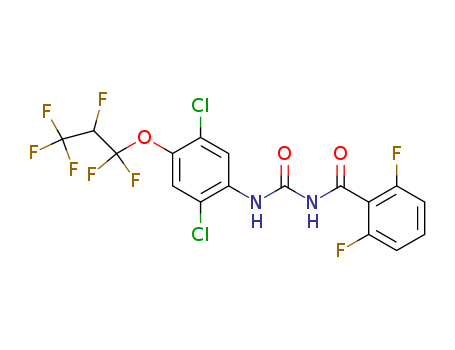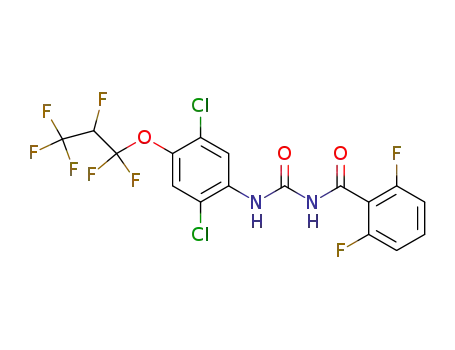Lufenuron
-
Product Name :
Lufenuron
-
CAS No :
103055-07-8
-
Project State :
Commercial

Application
General Description
Buy cost-effective 99% pure Lufenuron 103055-07-8 now
- Molecular Formula:C17H8Cl2F8N2O3
- Molecular Weight:511.155
- Appearance/Colour:COA
- Vapor Pressure:<0.4 x10 -3 Pa (25 °C)
- Melting Point:174.1°
- Refractive Index:1.522
- PKA:8.49±0.46(Predicted)
- Flash Point:170 °C
- PSA:67.43000
- Density:1.631 g/cm3
- LogP:6.56940
Lufenuron(Cas 103055-07-8) Usage
|
Flammability and Explosibility |
Notclassified |
|
Pharmacology |
Antiparasitic. Lufenuron is a benzoylurea insecticide. This class of insecticides was previously used on fruits to decrease damage by insects. Lufenuron (Program) has been used for prevention of flea infections in dogs and cats because it inhibits chitin synthesis. For this use, it has been given to dogs at a dose of 10 mg/kg every 30 days and to cats at a dose of 30 mg/kg every 30 days. It may also have some inhibition on fungal cell membranes because it inhibits the cell wall of fungi, which contain chitin, and other complex polysaccharides. Because of this property on fungal cell membranes, there has been interest in using lufenuron to treat dermatophytes in small animals. However, proven efficacy has been controversial. Well-controlled studies have not confirmed consistent efficacy for treating dermatophytes in animals. |
|
Veterinary Drugs and Treatments |
Lufenuron is approved for use in dogs and cats 6 weeks of age and older for the control of flea populations. The combination product of lufenuron and milbemycin (Sentinel?) is indicated for use in puppies and dogs 4 weeks and older for prevention and control flea populations, prevention of heartworm disease, control of adult hookworms, and the removal and control of adult roundworms and whipworms. Lufeneron showed initial promise as a treatment for fungal infections, but the early enthusiasm has dampened considerably as efficacy appears doubtful. |
|
Metabolic pathway |
Only limited information is available in the open literature on the metabolism of lufenuron. |
|
Degradation |
Lufenuron is less stable at alkaline pH than under acidic conditions. The DT50 at 25 °C is 160 days at pH 5,70 days at pH 7 and 32 days at pH 9 (PM). |
|
Mode of action |
Lufenuron has no systemic or translaminar effect. It is persistent with a transovarial effect. It may reduce the egg-Iaying rate or hinder the hatching process of embryos. |
|
Definition |
ChEBI: Lufenuron is a benzoylurea insecticide, a dichlorobenzene, a N-acylurea, an aromatic ether and an organofluorine compound. |
InChI:InChI=1/C17H8Cl2F8N2O3/c18-6-5-11(32-17(26,27)14(22)16(23,24)25)7(19)4-10(6)28-15(31)29-13(30)12-8(20)2-1-3-9(12)21/h1-5,14H,(H2,28,29,30,31)
103055-07-8 Relevant articles
Method for exterminating termites
-
, (2008/06/13)
A method for exterminating termites comp...
Insecticidal combination to control mammal fleas, in particular fleas on cats and dogs
-
, (2008/06/13)
Process and composition, in particular f...
Method for the treatment of coccidioidomycosis in warm-blooded animals
-
, (2008/06/13)
This invention relates to the use of acy...
103055-07-8 Process route

-

-
103055-07-8
lufenuron
| Conditions | Yield |
|---|---|
|
|
|
|
|
|
|
|
|
|
|


